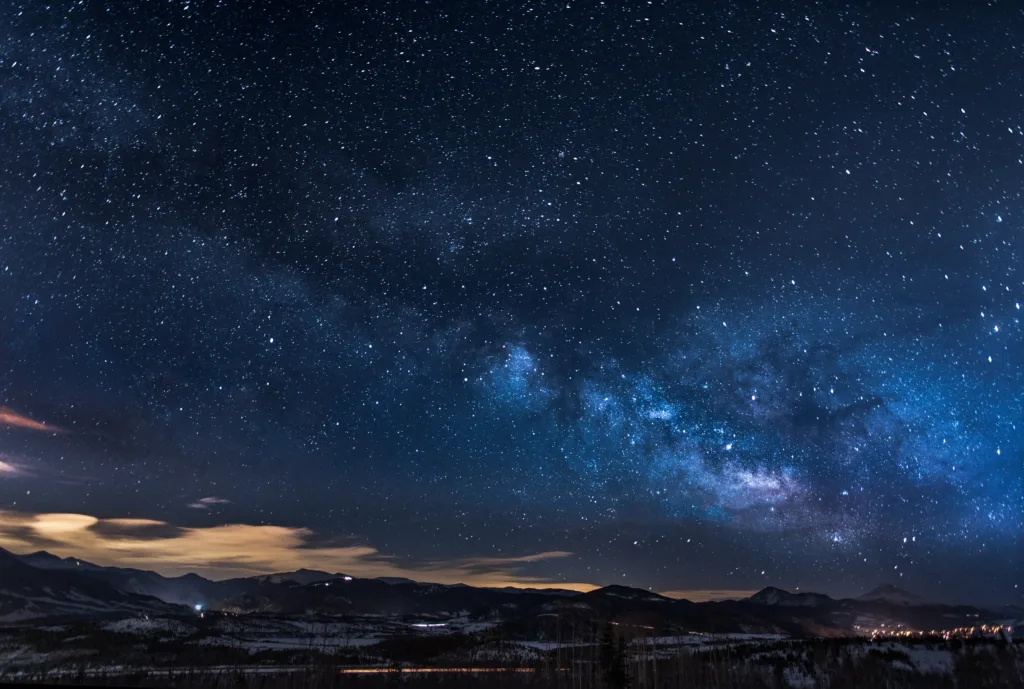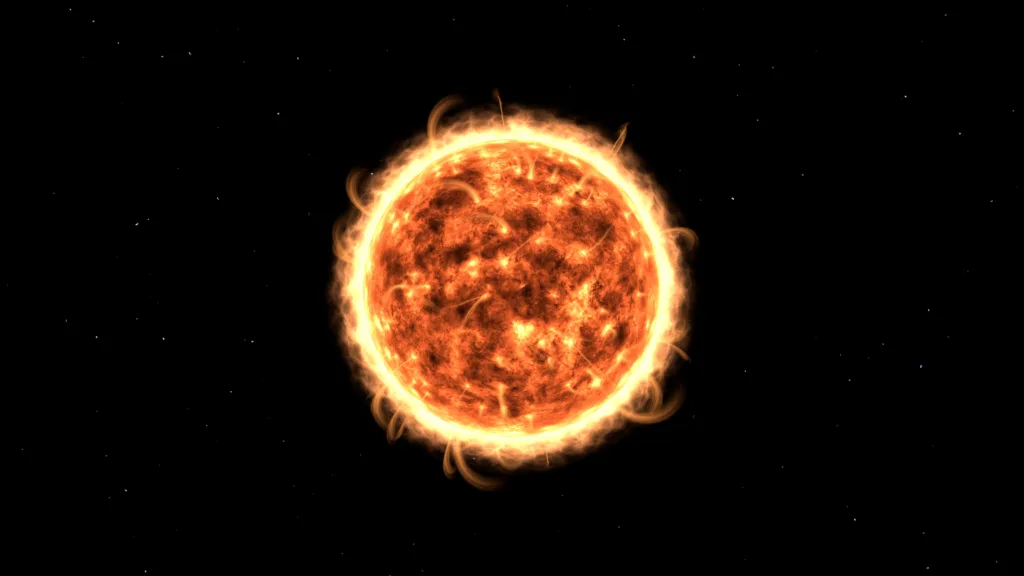Stars are fascinating celestial objects that have captivated humans for centuries. They are giant spheres composed of plasma, which is a superheated state of matter. These stellar bodies emit light and heat due to the intense nuclear reactions happening at their cores.
From our perspective on Earth, stars appear as tiny, twinkling points of light in the night sky. This is because they are incredibly far away, even the closest star to us, apart from the Sun, is many light-years away. The immense distance makes them appear as mere dots, devoid of any discernible shape.
However, if we were to approach a star up close, we would see that it is actually a massive ball of glowing gas. Imagine a colossal, smoky balloon with a popcorn-like texture, illuminated from within. These stars are enveloped in wispy trails of glowing smoke, further adding to their mesmerizing beauty.
The Sun, our very own star, is much larger and brighter than most other stars in the galaxy. In fact, there are billions of other stars in our Milky Way galaxy alone, many of which are similar to our Sun. These stars, or Suns, emit a significant amount of energy, giving them their brilliance and making them visible from such vast distances.
One interesting aspect of stars is their color, which can vary depending on their temperature. Hotter stars tend to appear white or blue, while cooler stars have orange or red hues. This variation in color is a result of the different temperatures at which the stars burn.
Stars are not the only celestial objects that we see when we gaze up at the night sky. Other objects, such as planets, asteroids, and even galaxies, can also be visible. However, stars are unique in their ability to emit their own light, whereas other celestial bodies are illuminated by the light of stars.
Stars are awe-inspiring objects that appear as tiny points of light in the night sky. While they may seem unremarkable from a distance, up close they reveal themselves to be massive, glowing balls of gas. The Sun, our closest star, is larger and brighter than most others in the galaxy. Stars can vary in color, with hotter ones appearing white or blue and cooler ones displaying orange or red hues. Their beauty and wonder continue to captivate and inspire us to explore the mysteries of the universe.
What Actually Stars Look Like?
Stars are actually giant balls of plasma, which is a state of matter consisting of highly ionized gas. They are incredibly hot and bright, emitting vast amounts of energy in the form of light and heat. Due to their immense distance from us, stars appear to be small, twinkling points of light in the night sky.
Here are some key characteristics of stars:
1. Size: Stars come in a range of sizes, from relatively small ones called dwarf stars to massive giants. The size of a star determines its brightness and lifespan. Larger stars are hotter and brighter, while smaller stars are cooler and dimmer.
2. Color: Stars can vary in color, depending on their temperature. The hottest stars appear blue or white, while cooler stars appear yellow, orange, or red. This color variation is due to the different wavelengths of light emitted by stars at different temperatures.
3. Shape: From our perspective on Earth, stars appear as point-like objects in the night sky. However, stars are actually spherical in shape, similar to our Sun. The reason they appear as points is because of their immense distance from us. The light from stars travels a long distance before reaching our eyes, causing them to appear as tiny dots.
4. Twinkling: Stars appear to twinkle or shimmer in the night sky. This twinkling effect is caused by the Earth’s atmosphere. As starlight passes through the layers of the atmosphere, it gets refracted or bent, resulting in the twinkling effect. The twinkling can also be affected by atmospheric conditions and turbulence.
5. Patterns: Stars are not randomly scattered in the sky. They form patterns called constellations, which are groups of stars that appear to form a recognizable shape or figure. These patterns have been used by civilizations throughout history for navigation and storytelling.
Stars are spherical balls of plasma that emit light and heat. Although they appear as tiny points of light from our perspective on Earth, they are actually much larger and come in various sizes and colors. The twinkling effect of stars is caused by the Earth’s atmosphere, and they form patterns known as constellations in the night sky.

What Does Stars Look Like Close Up?
When observed up close, stars appear as massive spheres of luminous gas, surrounded by swirling trails of glowing smoke. They exhibit a popcorn-like texture, with intricate patterns and structures. The interior of a star emits a radiant light, illuminating its surroundings. The surface of a star might resemble a smoky balloon, constantly in motion and emitting bursts of fiery streams at irregular intervals.
Key Features of Stars Up Close:
1. Enormous Balls of Gas: Stars are comprised of vast amounts of hot, glowing gases such as hydrogen and helium. Their immense size contributes to their intense brightness and heat.
2. Wispy Trails of Glowing Smoke: These trails, often referred to as stellar atmospheres, are composed of various elements and compounds that are expelled by the star and then illuminated by its internal light.
3. Popcorn-like Texture: The surface of a star can exhibit a texture reminiscent of popcorn, featuring small, irregularly shaped structures and formations.
4. Internal Illumination: Stars emit light from their interiors, which illuminates the surrounding gases and creates a radiant glow.
5. Dynamic Motion: Stars are in a constant state of motion, with turbulent processes occurring within their atmospheres. This movement contributes to the ever-changing appearance of stars up close.
6. Occasional Bursts of Fire: Stars may emit jets or streams of fiery matter at irregular intervals, adding to the dynamic nature of their appearance.
Observing stars up close provides a fascinating glimpse into the intricate and captivating nature of these celestial objects. The combination of their immense size, radiant illumination, and dynamic behaviors creates a mesmerizing visual spectacle.
Is Every Star Is A Sun?
Not every star is a Sun. While the Sun is indeed a star, it is unique in that it is the star closest to Earth and plays a vital role in our solar system. Here are some key points to consider:
1. Definition of a star: A star is a luminous celestial body made up of hot gases, primarily hydrogen and helium, that undergoes nuclear fusion in its core, releasing vast amounts of energy in the form of light and heat.
2. The Sun as a star: The Sun is classified as a G-type main-sequence star, also known as a yellow dwarf. It is relatively average in size, temperature, and luminosity compared to other stars. Its proximity to Earth allows us to study it in great detail.
3. Other types of stars: Stars come in various sizes, temperatures, and colors. They can be classified into different spectral types, such as O, B, A, F, G, K, and M, based on their surface temperature. These spectral types determine the color of the star, with hotter stars appearing bluish-white and cooler stars appearing red.
4. Size and brightness: The Sun is larger and brighter than most stars, but there are stars that far surpass its size and luminosity. Some stars, known as supergiants, can be hundreds or thousands of times larger than the Sun. On the other hand, there are also smaller stars, such as red dwarfs, which are much smaller and dimmer.
5. Number of stars: The universe is filled with a vast number of stars, estimated to be in the billions or even trillions. In our own Milky Way galaxy, there are estimated to be around 200-400 billion stars. While many of these stars are similar to the Sun, there is a wide range of sizes and characteristics among them.
While the Sun is indeed a star, not every star is a Sun. Stars come in various sizes, temperatures, and luminosities, and the Sun is just one of the many stars in the universe.
What Do Stars In The Sky Look Like?
Stars in the sky appear as tiny points of light. They can vary in brightness, depending on their luminosity and distance from Earth. The luminosity of a star refers to the amount of energy it emits. Therefore, brighter stars appear more luminous in the sky.
The color of stars can also differ because their temperatures are not uniform. Hotter stars tend to appear white or blue, while cooler stars have orange or red hues. This variation in color adds to the visual diversity of stars in the night sky.

Conclusion
Stars are fascinating celestial objects that exist in vast numbers throughout our galaxy and beyond. They are giant balls of plasma, emitting light and heat through nuclear fusion reactions in their cores. While stars may appear as tiny dots in the night sky, they are actually massive and complex structures, often surrounded by glowing gas and dust. The Sun, our closest star, is larger and brighter than most other stars in the galaxy. However, the brightness and color of stars can vary depending on their luminosity, temperature, and distance from Earth. Hot stars tend to appear white or blue, while cooler stars exhibit orange or red hues. Understanding the nature and characteristics of stars is vital in furthering our knowledge of the universe and our place within it.
